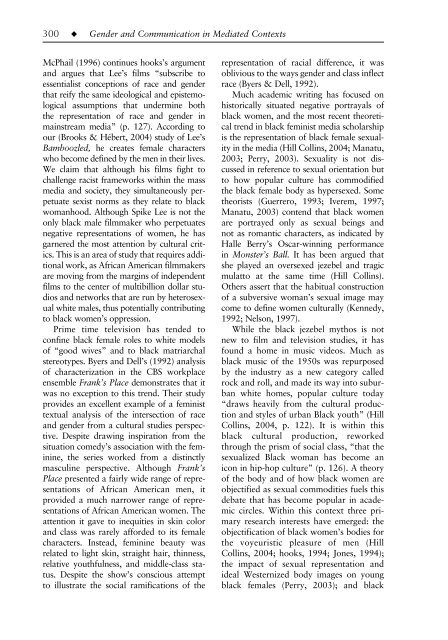Gender, race, and media representation - afghan
Gender, race, and media representation - afghan
Gender, race, and media representation - afghan
Create successful ePaper yourself
Turn your PDF publications into a flip-book with our unique Google optimized e-Paper software.
16-Dow-4973.qxd 6/11/2006 1:42 PM Page 300<br />
300–––◆–––<strong>Gender</strong> <strong>and</strong> Communication in Mediated Contexts<br />
McPhail (1996) continues hooks’s argument<br />
<strong>and</strong> argues that Lee’s films “subscribe to<br />
essentialist conceptions of <strong>race</strong> <strong>and</strong> gender<br />
that reify the same ideological <strong>and</strong> epistemological<br />
assumptions that undermine both<br />
the <strong>representation</strong> of <strong>race</strong> <strong>and</strong> gender in<br />
mainstream <strong>media</strong>” (p. 127). According to<br />
our (Brooks & Hébert, 2004) study of Lee’s<br />
Bamboozled, he creates female characters<br />
who become defined by the men in their lives.<br />
We claim that although his films fight to<br />
challenge racist frameworks within the mass<br />
<strong>media</strong> <strong>and</strong> society, they simultaneously perpetuate<br />
sexist norms as they relate to black<br />
womanhood. Although Spike Lee is not the<br />
only black male filmmaker who perpetuates<br />
negative <strong>representation</strong>s of women, he has<br />
garnered the most attention by cultural critics.<br />
This is an area of study that requires additional<br />
work, as African American filmmakers<br />
are moving from the margins of independent<br />
films to the center of multibillion dollar studios<br />
<strong>and</strong> networks that are run by heterosexual<br />
white males, thus potentially contributing<br />
to black women’s oppression.<br />
Prime time television has tended to<br />
confine black female roles to white models<br />
of “good wives” <strong>and</strong> to black matriarchal<br />
stereotypes. Byers <strong>and</strong> Dell’s (1992) analysis<br />
of characterization in the CBS workplace<br />
ensemble Frank’s Place demonstrates that it<br />
was no exception to this trend. Their study<br />
provides an excellent example of a feminist<br />
textual analysis of the intersection of <strong>race</strong><br />
<strong>and</strong> gender from a cultural studies perspective.<br />
Despite drawing inspiration from the<br />
situation comedy’s association with the feminine,<br />
the series worked from a distinctly<br />
masculine perspective. Although Frank’s<br />
Place presented a fairly wide range of <strong>representation</strong>s<br />
of African American men, it<br />
provided a much narrower range of <strong>representation</strong>s<br />
of African American women. The<br />
attention it gave to inequities in skin color<br />
<strong>and</strong> class was rarely afforded to its female<br />
characters. Instead, feminine beauty was<br />
related to light skin, straight hair, thinness,<br />
relative youthfulness, <strong>and</strong> middle-class status.<br />
Despite the show’s conscious attempt<br />
to illustrate the social ramifications of the<br />
<strong>representation</strong> of racial difference, it was<br />
oblivious to the ways gender <strong>and</strong> class inflect<br />
<strong>race</strong> (Byers & Dell, 1992).<br />
Much academic writing has focused on<br />
historically situated negative portrayals of<br />
black women, <strong>and</strong> the most recent theoretical<br />
trend in black feminist <strong>media</strong> scholarship<br />
is the <strong>representation</strong> of black female sexuality<br />
in the <strong>media</strong> (Hill Collins, 2004; Manatu,<br />
2003; Perry, 2003). Sexuality is not discussed<br />
in reference to sexual orientation but<br />
to how popular culture has commodified<br />
the black female body as hypersexed. Some<br />
theorists (Guerrero, 1993; Iverem, 1997;<br />
Manatu, 2003) contend that black women<br />
are portrayed only as sexual beings <strong>and</strong><br />
not as romantic characters, as indicated by<br />
Halle Berry’s Oscar-winning performance<br />
in Monster’s Ball. It has been argued that<br />
she played an oversexed jezebel <strong>and</strong> tragic<br />
mulatto at the same time (Hill Collins).<br />
Others assert that the habitual construction<br />
of a subversive woman’s sexual image may<br />
come to define women culturally (Kennedy,<br />
1992; Nelson, 1997).<br />
While the black jezebel mythos is not<br />
new to film <strong>and</strong> television studies, it has<br />
found a home in music videos. Much as<br />
black music of the 1950s was repurposed<br />
by the industry as a new category called<br />
rock <strong>and</strong> roll, <strong>and</strong> made its way into suburban<br />
white homes, popular culture today<br />
“draws heavily from the cultural production<br />
<strong>and</strong> styles of urban Black youth” (Hill<br />
Collins, 2004, p. 122). It is within this<br />
black cultural production, reworked<br />
through the prism of social class, “that the<br />
sexualized Black woman has become an<br />
icon in hip-hop culture” (p. 126). A theory<br />
of the body <strong>and</strong> of how black women are<br />
objectified as sexual commodities fuels this<br />
debate that has become popular in academic<br />
circles. Within this context three primary<br />
research interests have emerged: the<br />
objectification of black women’s bodies for<br />
the voyeuristic pleasure of men (Hill<br />
Collins, 2004; hooks, 1994; Jones, 1994);<br />
the impact of sexual <strong>representation</strong> <strong>and</strong><br />
ideal Westernized body images on young<br />
black females (Perry, 2003); <strong>and</strong> black




